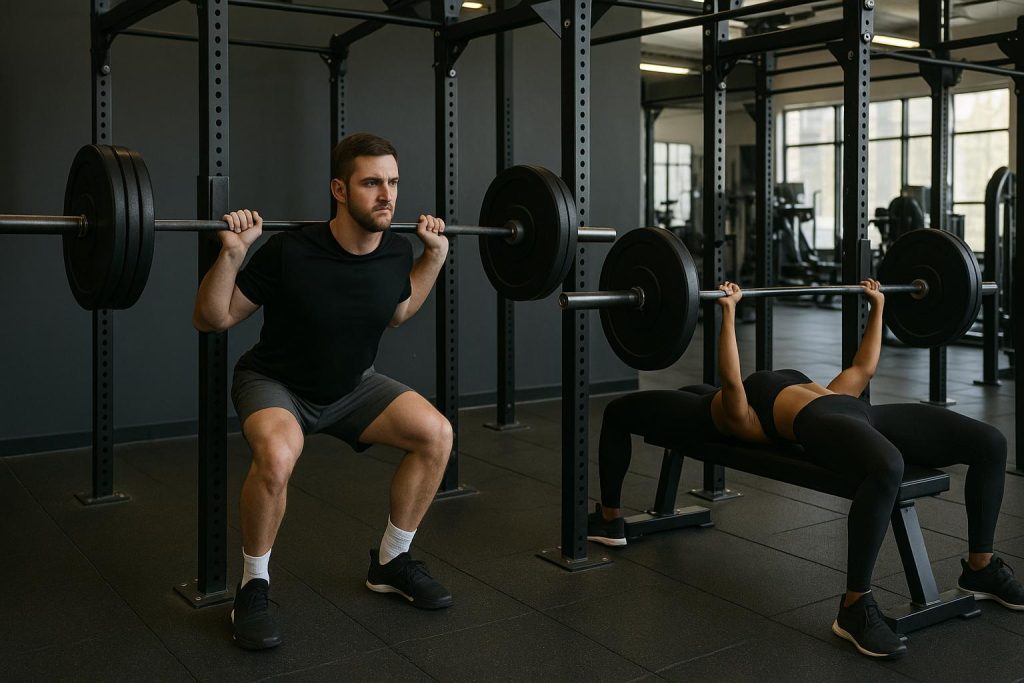The PHUL workout routine is a science-backed 4-day split designed to build both strength and muscle by training each muscle group twice per week. If you’re looking for an efficient and balanced program that fits intermediate and advanced lifters, PHUL is one of the best choices. It emphasizes both power (strength) and hypertrophy (muscle size) using a proven structure.
Understanding PHUL can help you break plateaus, maximize your training, and avoid common mistakes. This guide covers the schedule, sample exercises, pros, cons, and how to adapt PHUL for your goals—all with the latest updates.

What is the PHUL Workout Routine?
The PHUL (Power Hypertrophy Upper Lower) routine is a 4-day training split that alternates between strength-based (power) and muscle-building (hypertrophy) workouts. The program trains your upper and lower body twice a week, striking a unique balance for muscle and strength gains.
- Upper Power Day: Focuses on heavy compound lifts for the upper body.
- Lower Power Day: Focuses on heavy compound lifts for the lower body.
- Upper Hypertrophy Day: Uses moderate weights with higher reps for muscle growth.
- Lower Hypertrophy Day: Adds volume and accessories for legs and glutes.
Why PHUL?
- Efficient 4-day schedule fits busy lifestyles
- Built on proven strength science (Legion Athletics, 2024)
- Easily adjustable for most gym-goers
PHUL Workout Weekly Schedule (Sample Split)
| Day | Focus |
|---|---|
| Monday | Upper Power |
| Tuesday | Lower Power |
| Wednesday | Rest |
| Thursday | Upper Hypertrophy |
| Friday | Lower Hypertrophy |
| Saturday | Rest |
| Sunday | Rest |
Upper/Lower split = each muscle group is trained twice per week for optimal results (Muscle & Strength, 2024).
PHUL Training Principles & Science
- Dual Focus: Power (strength, low reps) + Hypertrophy (muscle growth, higher reps).
- Frequency: Muscles trained twice a week leads to more progress than a classic “bro split.”
- Compound Movements: Prioritizes squats, bench press, deadlifts for efficiency and functional strength.
- Volume & Intensity: Power days = heavier weight, fewer reps; Hypertrophy days = lighter weight, more reps.
Research backs this approach. Training muscle groups twice per week leads to more muscle growth than once per week (Stronger By Science, 2023).
PHUL Sample Program (Exercises, Sets & Reps)
Below is a classic PHUL template you can adapt. Warm up before every session and adjust weights to your experience level.
Day 1: Upper Power
- Barbell Bench Press: 3–4 sets x 3–5 reps
- Bent-Over Row: 3–4 sets x 3–5 reps
- Overhead Press: 3–4 sets x 6–8 reps
- Lat Pulldown: 3–4 sets x 6–8 reps
- Accessory (e.g., Triceps, Biceps): 2–3 sets x 8–12 reps
Day 2: Lower Power
- Squat: 3–4 sets x 3–5 reps
- Deadlift: 3–4 sets x 3–5 reps
- Leg Press: 3–4 sets x 6–10 reps
- Calf Raise: 3–4 sets x 8–12 reps
Day 3: Upper Hypertrophy
- Incline Dumbbell Press: 3–4 sets x 8–12 reps
- Seated Cable Row: 3–4 sets x 8–12 reps
- Dumbbell Lateral Raise: 3–4 sets x 12–15 reps
- Face Pull: 3–4 sets x 12–15 reps
- Arm/Shoulder Accessories: 2–3 sets x 10–15 reps
Day 4: Lower Hypertrophy
- Front Squat or Hack Squat: 3–4 sets x 8–12 reps
- Romanian Deadlift: 3–4 sets x 8–12 reps
- Leg Curl: 3–4 sets x 10–15 reps
- Seated Calf Raise: 3–4 sets x 12–15 reps
- Optional Glute/Quad Isolation: 2–3 sets x 12–15 reps
Rest at least 60–90 seconds between sets for hypertrophy, 2–3 minutes for power sets.
Pros & Cons of the PHUL Routine
Pros
- Builds Strength & Muscle Simultaneously: Perfect for body recomposition
- Efficient Schedule: Only 4 days per week, optimal for recovery (Hevy App, 2024)
- Easy to Adjust: Can add/modify accessory work as needed
- Backed by Science: Matches latest research for muscle-building frequency
Cons
- Sessions Can Be Lengthy: Especially upper body days (allow 60–75 minutes)
- May Be Too Intense for Complete Beginners: Better for intermediates and up
- Not for Specialization: Not ideal if your goal is ONLY strength or ONLY muscle mass
Common Questions About PHUL
Is PHUL Good for Beginners?
PHUL is best for those with at least 6–12 months of consistent training. New lifters may be overwhelmed by the volume.
How Do I Progress?
Increase weights or reps when you hit the upper end of each range for two consecutive weeks. Focus on good form.
Can PHUL Help Me Lose Fat?
Yes—when paired with a calorie deficit and sufficient protein intake, PHUL builds muscle while supporting fat loss.
Can I Do PHUL at Home?
You’ll need access to free weights and basic machines for the full experience. For home gyms, modify exercises (e.g., use resistance bands or dumbbells).
How to Modify the PHUL Program
- For More Muscle: Add 1–2 isolation exercises per muscle group on hypertrophy days.
- For Less Time: Cut 1–2 accessory exercises to keep workouts under 60 minutes.
- For Advanced Lifters: Try a 5- or 6-day PHUL+ variation for extra volume (Set for Set, 2024).
PHUL Routine: Fees, Memberships, and Apps
- PHUL is free to follow—just search for sample routines or use a free app (like Hevy or Boostcamp).
- No official subscription or paywall.
- Some trainers may offer PHUL coaching for a fee; rates vary ($30–$100+/month for personalized plans).
- Check your gym membership for required equipment access.
Conclusion
If you want a balanced, evidence-based approach to both muscle and strength, PHUL is one of the top programs you can use. Its twice-per-week frequency, proven science, and easy customization make it a favorite of intermediate lifters everywhere.
